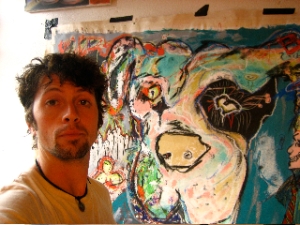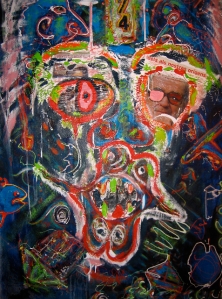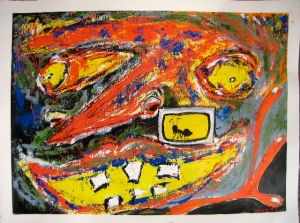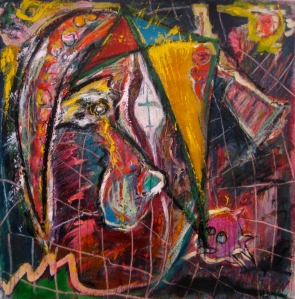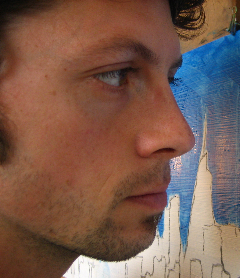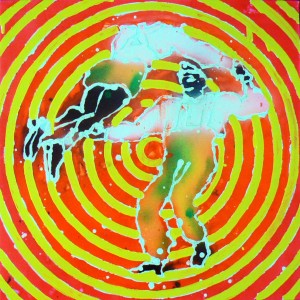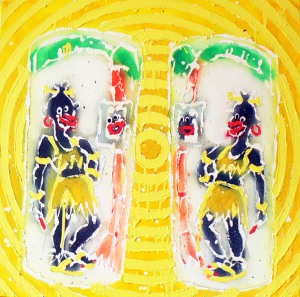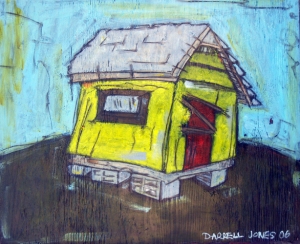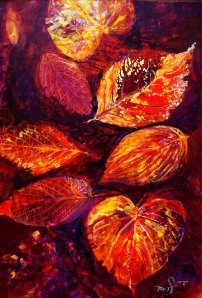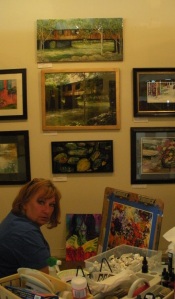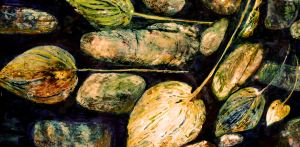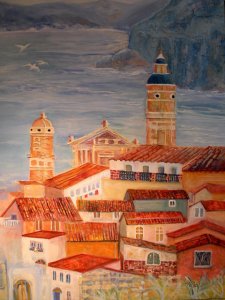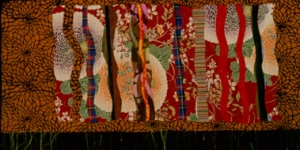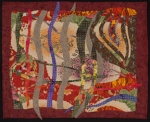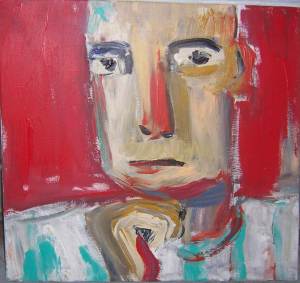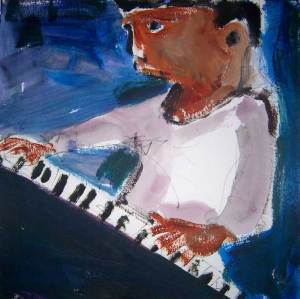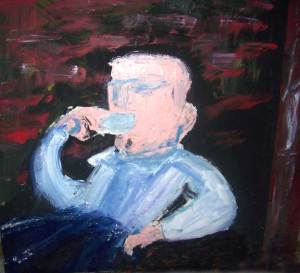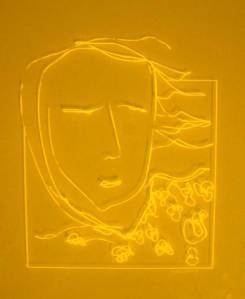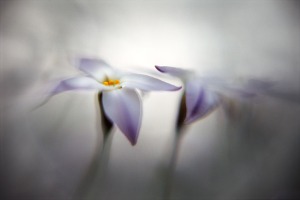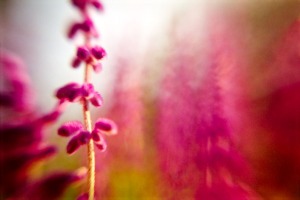Our Featured Artist of the Week – Marilyn Weiss
December 1, 2009

Marilyn Weiss, an accomplished artist for more than 30 years, considers herself to be first and foremost a collagist. The constant changing nature of this special medium always offers something new and allows her to work with an infinite variation of colors, textures and shapes.
A material world
While there is no specific material that is her favorite, Marilyn finds herself drawn to those that elicit history. She uses “bits and pieces” from her life or the lives of family and friends. Old papers, thread, strings, and buttons will often turn up in her work, as will fabric or yarn from a baby sweater or, possibly, a vintage dress.
The material is not used literally, rather it is melded into a piece so that it loses its original identity and takes on another. But each collage piece chosen has to have meaning and be relevant to the specific work – it is not just “stuck on”.
And yet, in the end, for Marilyn, collage is strictly an emotional process. She does not try to figure out why something works – she just feels it when it does.
Take “Cool Space” for example. The work is a hand-worked monotype, one of a series of three – this being the most colorful. It is a whimsical, bright and happy piece inspired by children and one can easilyvisualize the play between the real and the artificial.

Cool Space
“Just Me,” is a sweet and sentimental mixed media, collage. We witness a female figure sitting by herself, seemingly content and happy.

Just Me
A feminine touch
A self-proclaimed people person, Marilyn’s art usually includes human figures, and most often they are women. Fascinated by relationships and the way forms and figures interact, there is a dominant feminine theme and form in much of her work.
“You can say that I’m a feminist,” she explains. “Not in a beat- yourself-over-the-head kind of way, but in the fact that I always paint women. I guess I’m saying that we’re here and we’re important. It’s subtle, but it’s there.”
Some great examples of this genre of her work are “Studio View, Grays” and “Sister Act,” both intricate collages with a distinct feminine theme.
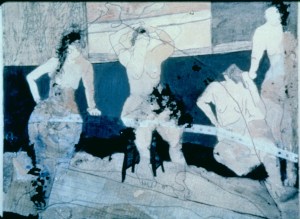
Studio Views, Grays

Sister Act
Weiss is quite clear that she loves what she does – creating art gives her great pleasure. She believes that art is meant to be seen and enjoyed, and hopes that her work stirs sensibilities, provokes emotions and most importantly, brings joy to those who experience it.
After meeting her and studying the pieces offered in our upcoming December auction, we can say that her hopes have been achieved – we have thoroughly enjoyed getting to know both Marilyn Weiss and her wonderful body of work.
To view the ArtistsinAuction website click here.
To view more of Marilyn Weiss’ work, click here.

IN and OUT

Sunday Morning
Our Featured Artist of the Week – Zeke Berman
November 25, 2009

Goblet Portraits 1977
The work of Zeke Berman demonstrates a truly unique eye in the world of photography. We are truly grateful to have such a talented artist on board, partaking in our upcoming auction.
Berman has honed his craft over the last 35 years, producing singular, studio-based photographs that reflect his long-standing interest in visual cognition and optics.
His work has evolved much over the years but always explores an intersection between sculpture, photography and drawing.
From the outset Berman received strong critical acclaim. His work has been collected, published and exhibited in galleries and museums such as MoMA, The Metropolitan, The Whitney, and Art Institute of Chicago. He has been featured in the first New Photography Exhibition at MoMA and has received multiple awards, including the Guggenheim, NEA and NYFA Arts Fellowships.
In the beginning
As a kid, Berman loved sculpture. He attended the High School of Music and Art and studied sculpture at the Philadelphia College of Art. He only backed into photography after graduating. To date he approaches photography as a studio based art and his sculptural training clearly plays an important part in his working process.
During his years in art school, conceptual art and minimalism were a fresh aspect of contemporary art. At that time, Berman began a developing fascination in perception theory – a lifelong interest that involves questions of cognition, optical illusion and the evolution of the senses. The idea that an illusion can change in appearance, right before our eyes, is equally fascinating and inspiring to him.
His study found its way into his working process when he began to experiment with a camera in the studio. Berman’s epiphany came when he discovered a deep mystery and possibility in the transformation of a three-dimensional construction into a two-dimensional photograph.
A cumulative process
The formal range of Berman’s work and his sculptural use of materials is varied, original and idiosyncratic. All his pieces are intricately designed and constructed in his studio.
Berman uses a 4X5 studio view camera to create all his photography. The procedure is an old one that delivers extremely sharp, and clear prints, as well as images that are very realistic in the description of the materials used. The end result is often a photograph designed from a construction but with the appearance of a drawing.
His process is cumulative in nature – he makes photographic sketches constantly as he constructs and reconstructs, creating many, images as the work evolves. Intuition and spontaneity ensue throughout the process. We asked him how he knows when he has finally completed a piece. His answer is that it simply feels complete.
Optical illusion
In the late 1970’s Berman had a direct interest in creating different kinds of illusion. His work from this period clearly demonstrates optical illusion and the transformation of three-dimension into two-dimension.
“Cup with Objects” from 1979 is a great example of 3D/2D play. All the objects fill up the frame up to the edge, however, one slight shift of the camera and the pieces wouldn’t work together.

Cup with Objects
“Web,” a piece from the late 80’s contains an actual spider web. It is a very linear, abstract work, and one that clearly depicts the flow from drawing to sculpture to photography. In fact, much of his work from this time period was very linear in nature.

Web
Later pieces demonstrate the evolution and progression in his photography.
Take for example “Shoe and Tire,” a 1993 commission piece for Progressive Corporation, an auto insurance company. The company CEO is an avid art collector and commissioned Berman to create a suite of still life’s around which the company’s Annual Report was designed. He won several design awards for this work.

Shoe and Tire
“Heart,” created in 1995 was commissioned by graphic designer Mark Schwartz for his daughter who was born on Valentine’s day.

Heart
Although Berman rarely photographs people, “Standing Stack” from 1997 was made at a time when he wished to bring more human presence into his work.

Standing Stack
Berman lives and works in NYC. He now works mostly in color, a new turn in his evolving body of work.
To view the ArtistsinAuction website click here.
To view more of Zeke Berman’s work, click here.

Plant Slice 1999

Fat Lamp and Cherry Blossoms 2008
Our Featured Artist of the Week – Joni Diskint
November 20, 2009
Joni Diskint is fortunate to be a full-time artist – not a luxury afforded by many. She has set up her home in Chatham, New Jersey as a gallery – Joni Diskint Fine Art – specifically designed to showcase her work.
Her history probably dictated that she would set out on an artistic path. As a child, she was extremely creative, writing stories and making illustrations at a very young age. In fact, she nearly published a book when she was in the fifth grade.
The early years
But she only fully entertained the idea of being an artist when she was in college. She flourished in color and painting classes, received great feedback from professors, and decided to spend a year in London pursing her craft.
Things started to happen for her rather quickly. While living and painting in Colorado she began to show her work at local shows. At 25, she had her first show in Soho, NY, which marked the beginning of a yearly occurrence – she would show at a different gallery in Soho every year. At the time, she lived in the Berkshires, where she owned a gallery and would exhibit her work as well as that of other emerging artists.
At 30, she moved to the east side of NYC. “There was too much going on in the city not to be here”, she says. Soon her work started selling in earnest, especially once she started offering prints of her pieces.
Seeing the light
The landscape is her inspiration – the colors and the light, as well as its never ending, constantly changing nature. In most of her pieces the sky plays an important role because it is forever moving and always conveying a unique type of light.
Take “Lonesome Valley,” a very evocative and challenging piece that conveys a dramatic, dark sky contrasting against the white snow. The piece is very deep and intense and is made from a very dark color palette. The ominous sky takes the viewer into a depth, to a different place.
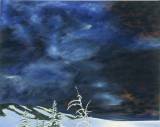
The “Oil Lamps” are equally evocative in their portrayal of light. She bought the lamps in India and uses them for meditation, mostly at night when they cast a very solemn glow. Her idea was to capture the dark, that is to paint the light within the dark, and her aim was to go as dark as possible. She had studied Vermeer and other masters who so artfully conveyed light, and so she felt the need to do so as well.

“Reflected Light” is another play on light, this time using the reflection of the sun against the trees at sunset. These trees are actually in her backyard and she worked endlessly to evoke the light to come through to the canvas.
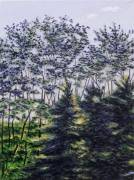
Joni sells through her home as well as through a variety of charity shows. She also has a separate studio attached to the house where she teaches painting classes. We invite you to view the work of our featured artist and to “see the light” in her varied works.
To view the ArtistsinAuction website click here.
To view more of Joni Diskint’s work, click here.
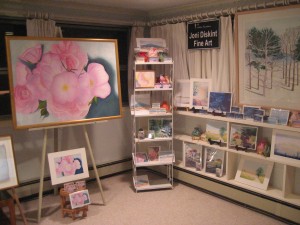
Our Featured Artist of the Week – Tom Smith
November 14, 2009
The collages of Tom Smith are optically stimulating and complex – viewers are often hypnotized by his mesmerizing work. So, we were eager to learn more about our featured artist’s creativity and the ways in which he developed his unique craft.
It turns out that Smith has art in his blood – his mother is an accomplished decorative artist and his father has a deep appreciation of the arts. So it was no wonder that he followed in the same footsteps. In fact, never once did he entertain the notion of doing anything in life that was non-creative.
Smith studied art in Baltimore, close to his hometown in Maryland, and majored in illustration due to his strong interest in narrative work and storytelling. He went on to graduate school to further pursue his metier. Half-way through his studies a light bulb went off in his head as he realized he had something definitive he wanted and needed to share with others.
The turning point
Fine artist and printmaker, Carroll Dunham, whom Smith assisted when he first moved to New York, was the most influential person in his early career. Carroll stripped down all of Tom’s work and forced him to focus strictly on drawing (he spent an entire year devoted to this particular craft).
As a result, Smith became more introspective and was able to move into the subconscious, channeling human interest into his pieces versus the other way around. After that significant one year period, he finally understood his creative sensibilities.
To date, all of Smith’s work is drawing based, whether he is painting, sculpting, photographing or making collages. He expects that his drawing will evolve to other forms of new media in the not too distant future.
Superhero meditation
Smith’s collages emerged directly from his massive collection of superheroes – comic books, figurines, etc. The idea was to meld character images and witness the optical illusions he was able to produce. In fact, he discovered that a character could be completely transformed through the introduction of another image.
His process is equally transformative. The meticulous skill involved, although highly technical, is extremely repetitive and, therefore, exceedingly meditative. At first he is in control, but soon control flies out the window as he begins to manipulate images. A discovery element is always present as he never is quite sure what will emerge.
Color theory and the work of Josef Albers also play a large part in Smith’s collage work. All the pieces are based on the intermeshing of colors and the appearance of images as a consequence of color selection and interaction.
Take Untitled (red, yellow, blue), one of the first pieces he designed. Smith decided to create a collage based on the primary colors of red, yellow and blue – the three opposite sides of the color spectrum. Poring through the hundreds of images in his possession, he had to uncover three images that not only bore the requisite colors but were also standing upright. Combining them, he was able to create a figurative piece with the characters in the middle, successfully intersecting Minimalist art with Contemporary art.
Untitled (magenta) is equally illusionary. In this work, we witness a woman with minimal clothing represented in a very special way as her image is placed among a field of pinks and magentas.
In Untitled (bird and gun) we see two women, one holding a bird, the other, a gun, both with identical background colors. The resulting image is the appearance of two individuals in one space, despite the fragmentation. The piece has been pushed into a very simplistic direction, yet can be very disorienting to the viewer.
Smith’s collage work has been very influential to his other work. For example, collage, which is two-dimensional, naturally transcended into sculpture, which is three-dimensional. He tells us that he is getting ready to produce an entirely new body of work, utilizing figurative aspects, yet in the realm of the landscape.
Tom currently lives and works in New York City and has the unique opportunity to be working full-time in a studio assisting a number of established artists. He admits his good fortune and loves that he is always learning new techniques and staying “au courant,” not to mention extremely motivated. Plus, he gets to feed on the creative energy when he uses the studio for his own work at night and on weekends.
We invite you to peer into the hypnotic and magnetic work of a very talented artist.
To view the ArtistsinAuction website click here.
To view more of Tom Smith’s work, click here.
Our Featured Artist of the Week – Dulcie Dee
November 5, 2009
Dulcie Dee, an American born Chinese artist, is also a native New Yorker who grew up on the Upper West Side. Her grandfather, Dee C. Chuan, was the founder of the China bank in Manila, Philippines. As a result of this familial tie, Dulcie was sent over by her father in the early 1970s to meet her Asian relatives. She spent much time during her growing years in the Philippines and received her Bachelor of Arts degree from the University in Manila.
After college Dee became a freelance artist, working for the big ad agencies in NYC as a hands-on graphic designer for the better part of 15 years. She always painted and exhibited in shows along the way, the first in 1992, which was a one-woman show.
The Geisha Exposed
Her experiences in Manila were a real eye opener and initiated the start of her unique painterly style of Asian Art. She pored over the books in the local libraries and found loads of inspiration.
In the 1980s Dee started copying the Japanese shunga wood block print masters who had so fascinated her, such as Utamaro and Yoshitoshi. Mainly, she would copy Samurais and Geishas to paper. First she used color pencil, as well as pen and ink to simulate the wood block, but over the years she finessed the work to suit her distinct style. Interestingly enough, many of her Geisha paintings are self-portraits.
After four years in San Francisco, where she received her Masters, she came back to NY and started on a new Madame Butterfly series, a total of 12 pieces where she decidedly opened up the kimono and exposed the Geisha. Nicknamed the foreplay series, these works evoke a vibrancy based on color and semi-eroticism.
Soon after, in 2007, she participated in the Flashing Flesh group show at the Monkdogz gallery in Chelsea, marking the first time a Chelsea gallery exhibited her work.
Hard Times
“Peking Princess” came next. This large, oil on canvas is a self-portrait that depicts the Chinese girl painter caught amid the oncoming recession in NY. The blue/green hair symbolizes suffocation and struggle – life’s hardship where she is spinning her wheels and not really getting anywhere in terms of job prospects. The piece was shown earlier this year at the National Arts Gallery Roundtable, a show that included invited guest artists.
Dee currently lives and works in her studio apartment in the Financial district. She constantly paints but is eager to find work, and at this point, a roommate to help share the costs of living in NYC. We are excited to have her as one of our featured artists and wish her much success.
To view the ArtistsinAuction website click here.
To view more of Dulcie Dee’s work, click here.
Our Featured Artist of the Week – EGSilberman
October 30, 2009
Growing up Evan Graham Silberman (EGSilberman) never believed he could really become an artist, that is, as a true profession. He is still not sure it is possible, yet it is his dream.
In college he focused on advertising where he did loads of “art” work. And at one stage, when he began writing novels, he found painting to be a terrific release.
At first he worked on glass, building layers to the top surface and honing what would become his signature style – textured dimensionality. As glass became precarious (it breaks very easily), he discovered acetate, a great medium in which the artist can slowly form and build a piece, and with the similar ability that allows light to reflect through the surface.
The joy of light
All of EGSilberman’s work has a certain sparkle and joy based on light and texture. He uses acrylics to build dimensionality and acetate to capture light. At distinct times of the day his pieces often take on a different perspective, allowing the viewer to experience the light.
His work clearly expresses form over the literal. Take “Woman Form” for example. The piece starts with an actual hard plastic shape that a friend discovered. He applied his special white pigment paint and added adornments to create a lovely piece of sculpture.
In “Red Aquatic,” and most of his recent work, he creates a depth in which each part of the painting conveys a particular shadow. The piece is multi-dimensional, texturally-minded, and essentially built to play with light.
“Blue Woman” and “Chair Woman” are earlier works that focus more on the classic image than on dimensionality, while “Grapes,” a classic still life piece, is one of the few flat works in his repertoire.
A working apartment
Evan’s studio is a working apartment, as opposed to the other way around. Close to 500 pieces from more than 10 years of working are meticulously placed in every possible corner, nook and cranny.
He doesn’t really display his pieces much, in fact he hardly ever formally showcases his work as self promotion is not in his nature. Evan continues to write and work as a freelance advertising specialist, but is hopeful that his art will be more recognized in the future. We are very optimistic.
To view the ArtistsinAuction website click here.
To view more of EGSilberman’s work, click here.
Our Featured Artist of the Week – Roshan Houshmand
October 16, 2009
If travel is the key to art, then artist Roshan Houshmand has successfully unlocked the door to creativity.
Born in the Philippines, where she lived for eight years, Houshmand then moved to Iran, her native land. While she currently lives in upstate New York, she has resided in no less than half a dozen places all over the world, including New York City, New Mexico and Arizona. But, Barcelona, Spain, where she lived for ten years, was the most important place in her life as an artist.
The early years
When Housmand was a child her dad used to manage a paint factory. She fondly remembers her love of playing with the many samples at a very early age. Once she attended art classes, she began to dabble in many facets of the arts – painting, sculpture, lithography – experiencing it all, but she finally focused on painting.
In college her work was mainly abstract in nature, but her travels lead to new inspiration.
On Travel and Particle Theory
Houshmand believes that travel is essential to her painting because the experiences allow her to absorb different colors and visions and to move out of her comfort zone. She also feels that working under unfamiliar circumstances results in the discovery of different techniques. Currently, she teaches at SUNY Delhi as well as private painting students, many of whom join her for painting workshops each January at a chosen venue in the world.
Her flower series are specific examples of the influence of her travels and they emerged from time spent in the deserts of Arizona. These pieces just burst with color and Houshmand admits that some of the magic is due to the fact that these life forms were so out of context to the surroundings.
Houshmand’s most recent paintings are influenced by physics and, specifically, by a lecture that she attended in the summer of 2005 at Columbia University in New York. She soon began creating black and white pieces based on the following of particle trails, and later shifted the technique to color. She explains that this particular technique is all about painting in the moment.
One example is “Zed,” inspired by the photography of particle trails from bubble chambers. The spirals are trails that signify a certain amount of energy transmission and the title, oddly enough, is based on a wacky Dr. Seuss character.
“Celestial Chamber,” while based on particle trails, includes manipulated lines and conveys a sense of telescopic imagery. The horizontal and vertical lines, as well as the spirals, all remind her of map making.
The Painting is in the Process
“Constellation” and the other dot paintings were done in Nicaragua and are meditative compositions based on schools of fish. While creating this piece and others like it, she found a very soothing feeling in the process.
Houshmand paints everyday and she says the process itself is what gets her inspired. Her work continues to evolve over time and these days she is using much more color. All her pieces are extremely organic and one need not understand physics to gain a spiritual sense from her work.
She sells quite a bit of work off of her website as well as on other online venues, like ArtistsinAuction, and through local galleries. We are thrilled that she has joined us in our venture.
To view the ArtistsinAuction website click here.
To view more of Roshan Houshmand’s work, click here.
Our Featured Artist of the Week – Alex White-Mazzerella
October 8, 2009
Chaos, chemistry, creation. Three words that describe the unstructured and powerful works of Alex White-Mazzerella. Originally inspired by Expressionist painting, his art involves much freedom and spontaneity, with the ultimate aim of creating an expression and freezing it in time.
His process can start with a point of departure, like a sketch, but often just comes from his expansive imagination. Sometimes music can put him in a certain state of mind to create, and through the exercise of painting he finds the connection to the subconscious.
All his paintings evolve through many layers and he is constantly transforming them. He stops and concludes a piece if he feels a certain strength or the inclination that there is nothing left to be done.
A Boston native, White-Mazzerella only recently got into painting in earnest, although he admits developing a natural affinity to sketching and drawing at a very early age. Currently he works at the Art Student’s League in NY under the tutelage of Phillip Sherrod.
White-Mazzerella works with many different materials – pastels, charcoal, house paint, acrylics and pencil. His technique often involves dropping paint, which he believes effectively conveys the movement of time on paper.
He also creates collages, such as “Navigation Arf” – a whimsical look at traveling. The piece is of a large face with photos embedded in the eyes and mouth in an imaginary landscape.
“El Bicho” started with a sketch of an African tribal mask. It eventually evolved into something more whimsical.
“Rufus” originated from a color study and took off from there. He created a face, then deconstructed it and used the paint dropping technique to complete the work.
“Beware of Chinatown” is a whimsical take on Chinatown. White-Mazzerella lived in Hong Kong for a while and he saw first hand the ruthless experience of being a fish. Here you see a profile of a dog looking lasciviously at a fish.
Alex works fast and is very prolific. He generally spends four hours per day painting. He sells through galleries and can often be found on the streets of Soho on weekends offering his work.
His 2009 exhibition schedule has included Sideshow Gallery in Brooklyn, It’s a Wonderful Life Niagara Bar in Manhattan, as well as Urban Slant, Gallery Onetwentyeight, Art for Change, Hacia Afuera and Gelabert Studios Gallery, all located in Manhattan.
Alex is excited about his upcoming expo in Oslo, Norway and ArtistsinAuction is excited to have him as one of our featured artists.
To view the ArtistsinAuction website click here.
To view more of Alex White-Mazzarella’s work, click here.
Our Featured Artist of the Week – J. Kieran McGonnell
October 2, 2009
James Kieran McGonnell was born in Ireland, speaks with a lovely Irish lilt and has a keen affinity for most things Irish. And American.
He is highly influenced by artists hailing from his homeland, most notably Francis Bacon and Louis Lebroquay, both of whom emerged out of the post WWII art movement – the period known as Existentialism. He is also greatly persuaded by notable writers such as Yeats, Samuel Beckett, Jim Thompson and Virginia Woolfe, to name a handful.
So it’s not surprising that literature, history and art history all have an immeasurable effect on what he does. In fact, every one of McGonnell’s paintings is embedded with a rich history that is clearly evident.
History in the Making
Take “Red Herring” for example, in which circles reside within a square, a theme popularized in 50’s pop art and the work of American Color field painters, such as Kenneth Noland. The concept is a play on the idea of searching for something undefined. All the fish are in a regimented order depicting the routine and safety of everyday life. What will happen to them?
In “Once Upon a Spinning Time” two dancers are doing the jitterbug. The piece represents the first dance of Obama and his wife, Michelle, at the inauguration and evokes a snapshot out of the continuum in which you expect the future to have a certain and predictable outcome.
“After Dark My Sweet” is based on a Jim Thompson novel and a Yeats poem. The idea of moths drawn to a light conveys a sense of danger and the piece demonstrates the unpredictability of the future.
“Ghost Bike” is also based on a Yeats poem, conveying all the beauty in the world thus far, but that which cannot be experienced because it has passed. The bike is a symbol of the life of a person, the tragedy and beauty in history.
“A Pair of American Glasses” and “Live at the Green Mill – Radio Days” both symbolize American history– that which has long passed but stays with us forever.
The Method to the Motive
McGonnell has spent the past 15 years transferring images onto canvas. His technique is intense and intricate. First, he designs the images in his head, instilled by the inspiration of poems, literature, a muse of history or a reaction to daily life and living.
The ideas are then transferred to the computer, and through graphic imaging and photography the piece begins to take on a very conceptual shape. Next, McGonnell hand draws the entire piece on canvas with a pencil.
Finally, he paints. Through a combination of air brush spray paint and hand painting, utilizing high quality products containing silicones and resins, the work evolves into the finished masterpiece.
There is no question that Kieran McGonnell is a prolific and disciplined artist. He has been painting constantly for many years, currently in his upstairs studio, and works with galleries and dealers both in New York and Chicago, where he currently resides. He also shows once a year in Ireland. He says this has been the toughest year to date –no small statement from a talented artist such as he.
To view the ArtistsinAuction website click here.
To view more of J. Kieran McGonnell’s work, click here.
Our Featured Artist of the Week – Darrell Jones
September 25, 2009
As the middle child in a family of eight kids growing up in Memphis, Tennessee, you would not expect that Darrell Jones would have had the chance to pursue a career in art. But he did, thanks to a mom who encouraged him to proceed. Jones recalls drawing and sketching as early as kindergarten and remembers getting into trouble when he fashioned gestures of his teachers.
Jones went on to Jackson State in Mississippi where he took his first painting class. Because he was really into comic books, he later moved to Los Angeles and attended the Art Institute of California, studying animation and cartooning. He started working on numerous storyboards and got some coloring gigs to help pay the bills.
Abstract and Animation
Darrell moved to Atlanta to get a “real” job, but ironically that was the turning point in his art. He passed a homeless shelter that had an art gallery and he immediately got inspired to paint again. First he began painting pure abstracts, but soon moved on to scenes and backgrounds. It was then that he created his true style, fusing the abstract with animation. He says his style is kind of like when you look through the camera lens and see awkward angles. In the same way, his work tends to evoke a sense of distortion.
Darrell likes strong color, lots of action and never draws lines. He is inspired by every day life and simple experiences. He carries a sketchbook with him everywhere he goes and constantly gets new ideas. All of Jones’ paintings are acrylic on wood.
Series Painting
Many a time Darrell Jones paints in series – houses, fruit, jazz – to help him to avoid creativity blockage.
“Green House” was created during a routine walk to work. He used to leave his apartment and would always pass this old house in someone’s backyard. Was it an outhouse? It didn’t matter that the paint was peeling and that the structure was old and a little run down. Soon after he passed by another house – White House – on his way to the train station, and a series was hatched.
The “Going Green” series are all of inner city buildings that were inspired by watching the news on TV and hearing all this information about saving the planet. All these paintings have some sort of green in them. They also used recycled paint – when the paint dries up on his palette, instead of throwing it away Jones reuses it, piling it up on the canvas and painting over it.
“Shoes” are part of another series that depict everyday people in different circumstances. The old adage “you can tell a lot about someone by the shoes they wear” helped to kick off this series. Jones says that he went to some thrift stores and started making sketches of old shoes.
Tough Times
Darrell has been working diligently. He has been painting a lot since he hasn’t been working and has been averaging five pieces per month. He just recently finished another series of raised fists, all motivated by the recent campaign rallies.
Darrell is a closet artist and is slowly emerging to the public. It’s been real tough getting into galleries, but he has been making some money on pastel and oil portrait sketches. He was successful in our last auction and we hope the momentum continues this time around as well.
To view the ArtistsinAuction website click here.
To view more of Darrell Jone’s work, click here.
Our Featured Artist of the Week – Mary Sonya Conti
September 18, 2009
“Until you apply things with love you cannot start living,” says artist, Mary Sonya Conti. And there is no question that she thoroughly loves what she does. You can just hear it in her voice as she explains her unique techniques. But even more so, you can see the love she puts into every single piece of her art.
“Sonya” is a self taught artist that learned her craft at a very young age – long ago when her mom started craft night for she and her six siblings. Each kid had to create a different project from things collected outside the house. It was a great form of entertainment and a great way to expand the imagination, something she fears has gotten lost these days. Sonya clearly remembers collecting river rocks and tiling the bathroom floor at seven years old – a technique that has, ironically, become really popular today.
Much of Sonya’s work is based on tactile objects found in her garden – hosta and maple leaves, gravel, moss, and even dirt. She explains that the idea is to stay connected to what is around her so as to elicit a feeling and a mood- a defined focus from the many textured elements she uses. She admits she can even produce a fragrance from certain textures. If she does her job well the viewer will connect with the piece and further spark the imagination.
Unique techniques
One popular technique Sonya uses is with gauze. Concentrated watercolors are poured over the material, which is then draped to bring texture and lines. Once the piece has dried and the material is peeled back (sometimes she leaves the material in the work), the piece conveys the feel and texture of linen, and the colors are all blended naturally. Images are built slowly in this way. She then finishes the entire work by sealing the gauze with a glaze so it won’t deteriorate. As you can imagine, it’s a very time consuming process.
Five years ago, Sonya started teaching workshops in which she teaches her “laying” techniques, specifically, the laying of elements into color and certain pouring methods.
Her Work
“Through a Child’s Eye,” was created by highlighting the veining of hosta leaves. Acrylic inks were poured over and the “bones” were revealed once the leaves were peeled off. Then detailing began – pen and ink, as well as diluted watercolors were used to build up a glazing effect. Originally Sonya set out to create a peacock, but an excited child changed her mind in mid-creation and she just let the piece be what it was.
“Giving Tree” is part of a series in the ArtistChallenge.com. Artists are selected and invited to create based on a chosen theme. This one was based on the story about the giving tree, a tree that had supported a man all throughout his life. The group showcases their work in two monthly local galleries.
“Riviera” was a commission for the Dayton Philharmonic Opera House. It was actually housed in the ladies bathroom – greatly admired by all the women who saw it. “You have to start somewhere,” says Conti.
Mary Sonya Conti has two upcoming local shows in September, and she is up for selection as a mural artist for the city of Dayton, Ohio. We wish her much success.
To view the ArtistsinAuction website click here.
To view more of Mary Sonya Conti’s work, click here.
Our Featured Artist of the Week: Clairan Ferrono
September 11, 2009
To speak to Clairan Ferrono about her artwork is to receive a compelling and informational lesson on Fiber Art. Fiber Art was a medium of visual arts that we were not entirely familiar with until we brought Clairan on board and had a chance to speak with her about her craft. Prior to devoting her life to creating, exhibiting and selling her art, Clairan had been a Literature teacher for twenty years. You don’t have to be a genius to recognize that the art created by a former Literature professor will be nothing shy of smart, layered and textured.
In the mid 80’s when Clairan realized that traditional quilting could be made more exciting by simply fooling around with miscellaneous materials other than just patterns, she was unaware that it would change the direction of her entire life. Clairan taught herself how to machine quilt in 1989. She then attended the Q.S.D.S. (Quilt Surface Design Symposium) in 1997 in Columbus, Ohio and she says that it changed her life forever. She then returned home and began taking classes at the Studio Art Quilters Association with renowned art quilter Nancy Crow. Clairan will be the first to tell you that she has learned her skills from the best in the industry and her work supports that.
It was in 2001 that Clairan was ready to start exhibiting her Fiber work. Straight out of the gate, she received nothing but positive feedback and acceptance, which encouraged her to continue. The first two shows to which she submitted slides accepted her art. Since then she has been in lots of exhibitions and genuinely loves what she does.
A True Craft
One thing became clear during our interview with Clairan; the general population should be more aware of Fiber Art. The artist offered us a crash course lesson on the genesis of her work. Creating a piece of art for Clairan takes “huge amounts of time.” One piece can take up to a week to create. The labor-intensive process requires dying, painting, cutting and sewing. She uses prepared-for-dying fabrics (PFD) that she dies and paints. She also gets into screen-printing and block printing. Finally, she sometimes uses a collage technique called appliqué/reverse appliqué to achieve a dense visual surface. Clairan’s “work for the wall” is rich in layers, textures and technique. “Every random piece becomes harmonious” in her art.
Clairan finds inner peace while she works. Design and sewing are a form of meditation for her. In fact, creating her art has helped her heal emotionally during several difficult times in her adult life. She has extreme connection to certain pieces that she will never sell or let go of. A few pieces in particular: Last Conversation, Mother and Through a Daughter’s eyes are all autobiographical.
Right now, the prices of Fiber Art are extremely modest in the artist’s opinion. She does however foresee a boom in Fiber Art over the next five years. Clairan is constantly evolving in her work and we are honored to have her as one of our featured artists. Check out pieces in our Gallery like Runs Through It, Fields Web and Paintbox and you’ll see exactly what we’re talking about. You’ll see a real mature artist who is also a master of her craft.
To view the ArtistsinAuction website click here.
To view more of Clairan Ferrono’s work, click here.
Featured Artist of the Week – R. Gene Barbera
September 4, 2009
The work of Richard Eugene Barbera (he prefers Gene) has a youthful spirit and energy that is easy to get excited about, so we were extremely excited to talk to him. We played a little bit of phone tag because he was in Madrid, Spain with his wife and their three-month-old son on a visit to see his grandparents.
All of Gene’s work is chock full of attitude and expression. His influence started at a very young age. During his childhood in Portland, Maine he embraced the beauty of his surroundings, but unlike most Maine painters who got caught up with the intense scenery, Gene flocked to the various people that filled the working industries. He started taking classes at the Portland Art School just before his senior year in high school, where he made books of chalk and pastel drawings. A lot of his earlier work was done on beautiful antique music paper.
From those fisherman in his early life in Maine to the natives encountered during extensive travel around the world – all the various expressions and characters are what make up his paintings today. With unforgiving and meaningful one-stroke executions, he creates a distinct personality, often adding uncomplimentary colors and exaggerated cartoon-like features that result in a mysterious finish.
“People can understand and relate to figures,” Gene says of his work. He has always loved figures. He especially loves the feeling one receives when they see expression in the eyes. Gene recalls being moved by Richard Diebenkorn’s figures at a show in San Francisco in the late 70’s. He especially loved how the figures felt like huge slabs of paint.
We find the most thrilling aspect of Gene’s work not to be the energetic compositions that we are allowed to see on his canvases, but rather the mystique and intrigue of what we don’t see. Who are the figures that comprise his subject matter and what are they thinking and feeling?
Gene has sold some of his pieces, but it’s tough he says. For over fifteen years now he has been a slave to his craft – he is one of those artists who is always working on a painting or a drawing. He feels that art should be priced affordably so that more people can enjoy it. That makes Gene Barbera and his art a perfect addition to the ArtistsinAuction gallery.
Gene currently lives in Stanford, Connecticut.
To view the ArtistsinAuction website click here.
To view more of R. Gene Barbera’s work, click here.
Our Featured Artist of the Week: Billy Newman
August 12, 2009
ArtistsinAuction recently caught up with one of our newest contributors, nature photographer, Billy Newman, while he was hanging out at home with his wife in Newnan, Georgia. Billy works in both black & white and color, and he produces some of the most gorgeous images of nature and florals we have ever seen.
Unlike photographers who create a scene around a concept, Billy goes out and explores with his camera. Nothing is set up beforehand, and there is no preconceived plan of what he will be shooting. This makes a big difference because his work becomes a true form of self-expression. As Billy says, “When we create art we try and show a mirror of ourselves.”
While he definitely prefers color, his black & white images are equally stunning. We discovered that his black & white’s are actually tritonal – similar to the process of adding a duotone in Photoshop, he adds a tritone in order to add a little mystique to the image. It’s kind of like a painter using dark green, dark red and dark blue to create black instead of actually using black, which often flattens the work.
Billy has always been a fan of Monet’s Water Lilies, which is evident when you look at his color images. Witness pieces like Around, and Arise (in our gallery of images) and you’ll see what we mean.
Up until 6 months ago, Billy used conventional lenses and film, which he later scanned into digital images. He switched to digital, and now prefers it because he gains greater control over tone and color. His images are then printed through an archival inkjet process.
Billy, a prolific photographer, has previously sold his work through dealers into private corporation art collections. We are thrilled to have him participate in our upcoming auction, giving our buyers and collectors the chance to purchase exquisite works of nature photography at auction prices. Make sure to check out his collection of work offered at the Gallery section of http://www.artistsinauction.com!
There is no question that Kieran McGonnell is a prolific and disciplined artist. He has been painting constantly for many years, currently in his upstairs studio, and works with galleries and dealers both in New York and Chicago, where he currently resides. He also shows once a year in Ireland. He says this has been the toughest year to date –no small statement from a talented artist such as he.
To view the ArtistsinAuction website click here.
To view more of Billy Newman’s work, click here.

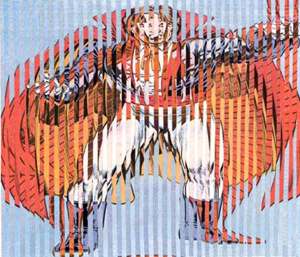
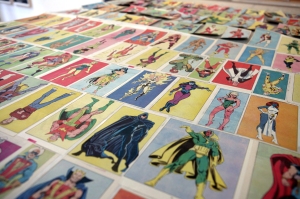



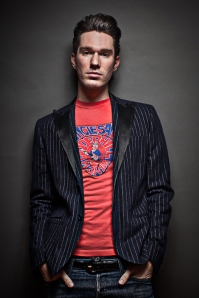


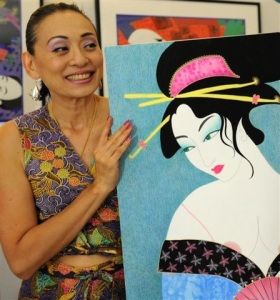
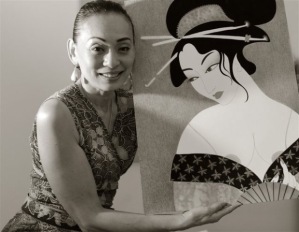
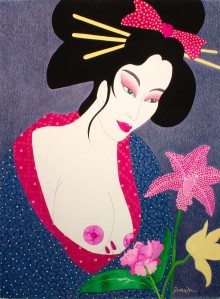



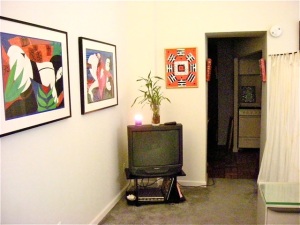

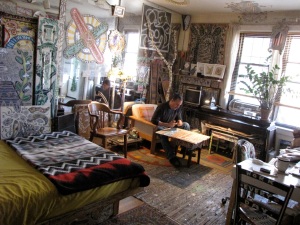
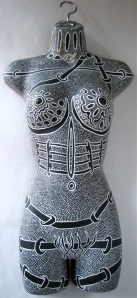
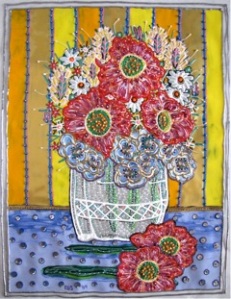



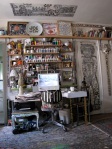
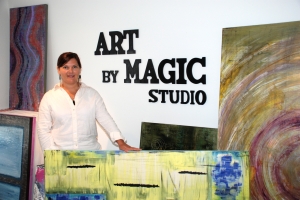
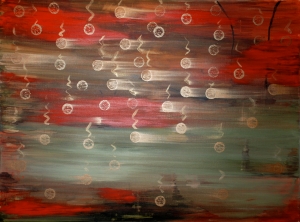

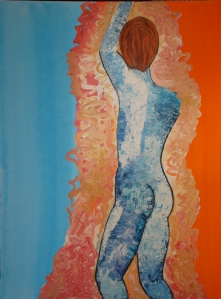
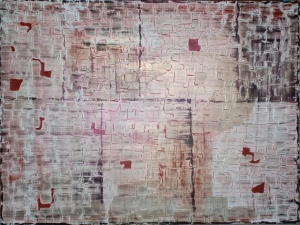

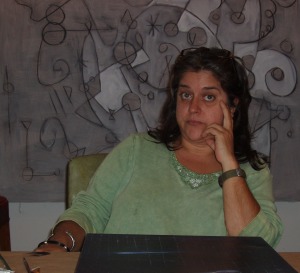
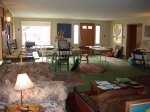
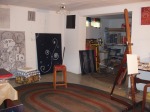
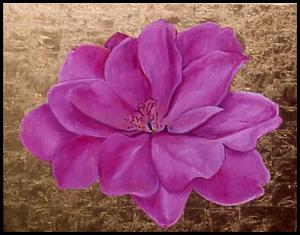
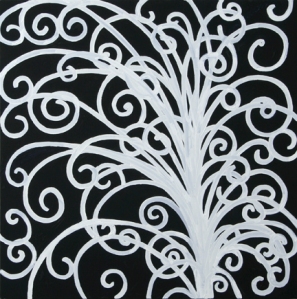
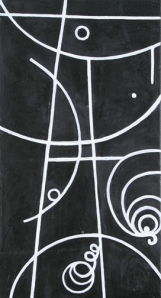
![Constellation[1].A Constellation](https://artistsinauction.files.wordpress.com/2009/10/constellation1-a.jpg?w=300&h=221)
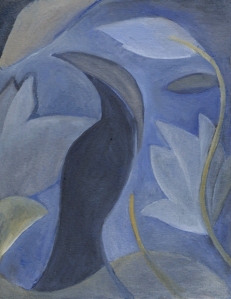
![Blue[1].A Blue](https://artistsinauction.files.wordpress.com/2009/10/blue1-a.jpg?w=300&h=148)
